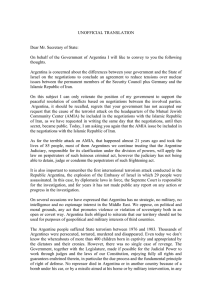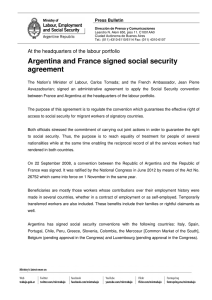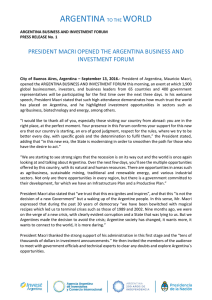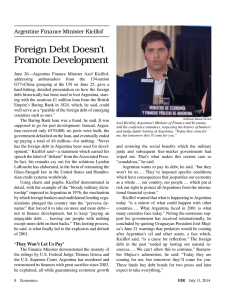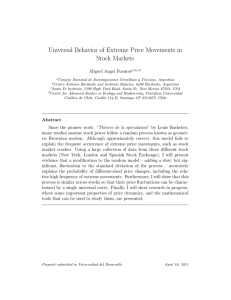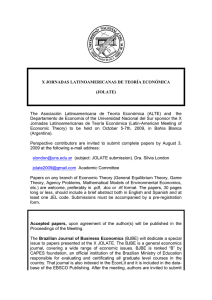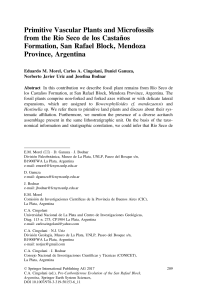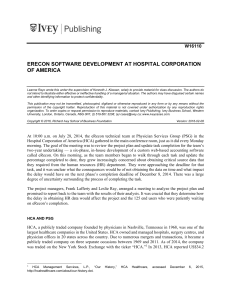Gutierrezia mendocina - Collectanea Botanica
Anuncio
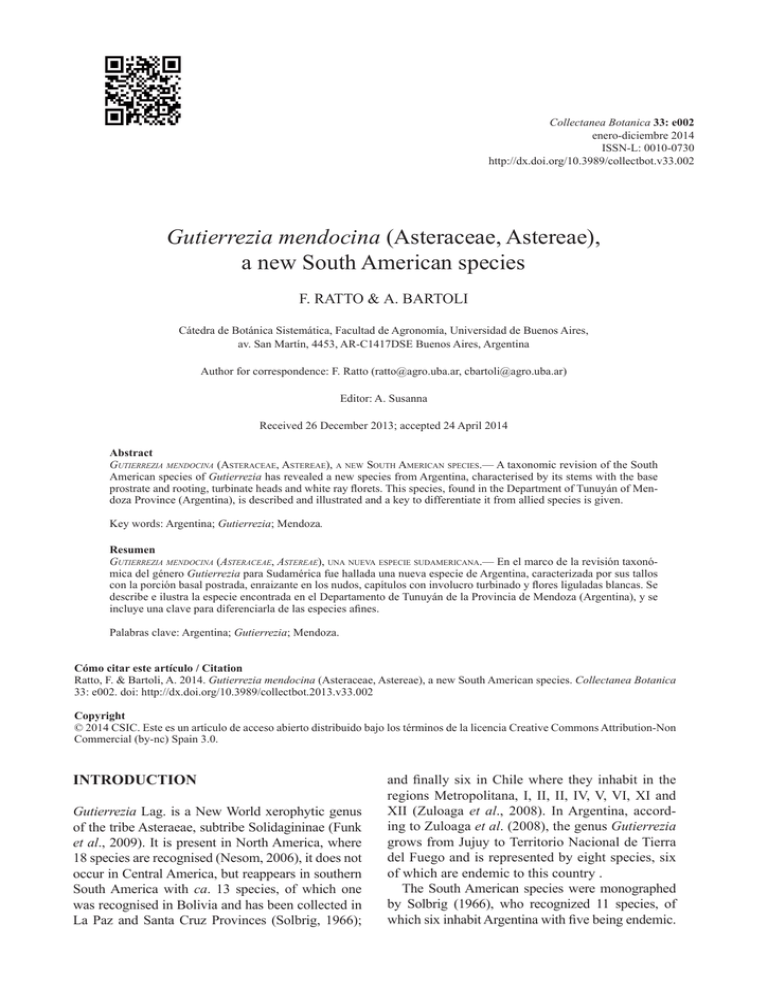
Collectanea Botanica 33: e002 enero-diciembre 2014 ISSN-L: 0010-0730 http://dx.doi.org/10.3989/collectbot.v33.002 Gutierrezia mendocina (Asteraceae, Astereae), a new South American species F. RATTO & A. BARTOLI Cátedra de Botánica Sistemática, Facultad de Agronomía, Universidad de Buenos Aires, av. San Martín, 4453, AR-C1417DSE Buenos Aires, Argentina Author for correspondence: F. Ratto ([email protected], [email protected]) Editor: A. Susanna Received 26 December 2013; accepted 24 April 2014 Abstract Gutierrezia mendocina (Asteraceae, Astereae), a new South American species.— A taxonomic revision of the South American species of Gutierrezia has revealed a new species from Argentina, characterised by its stems with the base prostrate and rooting, turbinate heads and white ray florets. This species, found in the Department of Tunuyán of Mendoza Province (Argentina), is described and illustrated and a key to differentiate it from allied species is given. Key words: Argentina; Gutierrezia; Mendoza. Resumen Gutierrezia mendocina (Asteraceae, Astereae), una nueva especie sudamericana.— En el marco de la revisión taxonómica del género Gutierrezia para Sudamérica fue hallada una nueva especie de Argentina, caracterizada por sus tallos con la porción basal postrada, enraizante en los nudos, capítulos con involucro turbinado y flores liguladas blancas. Se describe e ilustra la especie encontrada en el Departamento de Tunuyán de la Provincia de Mendoza (Argentina), y se incluye una clave para diferenciarla de las especies afines. Palabras clave: Argentina; Gutierrezia; Mendoza. Cómo citar este artículo / Citation Ratto, F. & Bartoli, A. 2014. Gutierrezia mendocina (Asteraceae, Astereae), a new South American species. Collectanea Botanica 33: e002. doi: http://dx.doi.org/10.3989/collectbot.2013.v33.002 Copyright © 2014 CSIC. Este es un artículo de acceso abierto distribuido bajo los términos de la licencia Creative Commons Attribution-Non Commercial (by-nc) Spain 3.0. INTRODUCTION Gutierrezia Lag. is a New World xerophytic genus of the tribe Asteraeae, subtribe Solidagininae (Funk et al., 2009). It is present in North America, where 18 species are recognised (Nesom, 2006), it does not occur in Central America, but reappears in southern South America with ca. 13 species, of which one was recognised in Bolivia and has been collected in La Paz and Santa Cruz Provinces (Solbrig, 1966); and finally six in Chile where they inhabit in the regions Metropolitana, I, II, II, IV, V, VI, XI and XII (Zuloaga et al., 2008). In Argentina, according to Zuloaga et al. (2008), the genus Gutierrezia grows from Jujuy to Territorio Nacional de Tierra del Fuego and is represented by eight species, six of which are endemic to this country . The South American species were monographed by Solbrig (1966), who recognized 11 species, of which six inhabit Argentina with five being endemic. 2 More recently, Sancho & Ariza Espinar (2003) published a floristic survey of Argentina where eight species are described, of which six are endemic. Recently, Sancho (2013) cited two species for the province of San Juan. However, since Solbrig (1966) there has not been a further taxonomic revision of the genus Gutierrezia. During the revision of the genus Gutierrezia we found one herbarium specimen collected by O. Boelcke in 1963 in western Argentina, near Mendoza city (Boelcke 10082, BAA). It was quite different from other South American species by its stems prostrate and rooting at the base, the shape of the leaves (the inferior elliptic-spathulate and the superior linear-elliptic), the turbinate involucre, and longer lamina of the ray florets, which are white in colour. A member of the team (F. Ratto) went to the original site of collection in the Department of Tunuyán (Mendoza Province) and found two populations of this species, all in a small area near Puesto de Gendarmería Alférez Portinari. RESULTS Gutierrezia mendocina Ratto & Adr. Bartoli, sp. nov. (Figs. 1 and 2). Inter species australibus Gutierreziae ligulis albis basi caulium repenti, foliis dimorphis, capitulis pedunculatis involucro turbinato 5–7 mm alto ligulis 5–6 mm differt. Type: Argentina, Mendoza: Dept. Tunuyán, Puesto de Gendarmería Alférez Portinari, 33º 36.40′ S, 69º 27.70′ W, 2167 m, 12.01.2011, F. Ratto, F. Marzaro & M. Bello 47 (holotype: BAA; isotypes BAA, BC, CTES, SI). Subshrubs 15–40 cm, much branched at the base. Stems erect, ribbed, glandular, leafy at the base and loosely foliaceous to the apex, with their base prostrate and rooting, Leaves subcoriaceous, sessile, 3–nerved, irregularly toothed at margin, with stipitate glandular trichomes and sessile glandular trichomes in pits on both blade surfaces; basal leaves elliptic–spathulate 15–22 × 3–4 mm, acute or semiobtuse; cauline leaves linear–elliptic 18–22 × 2–3 mm, acute. Heads radiate, heterogamous, pedunculate, 1–1.2 cm diam., arranged in corymbiform F. RATTO & A. BARTOLI cymes at stem apex; peduncles 5–20 mm, with 1 or 2 linear-elliptic bracts 3–5 mm long. Involucre turbinate, resinous, 5–7 mm × 3–5 mm. Receptacle flat or slightly convex, naked, pitted, pilose. Phyllaries in 3 graduated series, outer phyllaries oblong, glandular, acuminate, inner phyllaries narrowly obovate, apiculate. Ray florets 4 to 9, pistillate, with lamina white, narrowly obovate, 6–7 mm long.; style with branches linear-elliptic, apex obtuse, papilose. Disk florets 8 to 11, perfect, with corolla yellowish, 3–4 mm, tubular, with an abruptly ampliate throat. Anthers rounded at the base; apex of connective ovate to ovate elliptic; style branches elliptic, acute, with sweeping papillose trichomes on the outer side. Achenes grey, turbinate, densely sericeous; pappus of 14–16 linear-elliptic erosemargined scales, ca. 1 mm long. in ray florets and 2–2.5 mm long. in disk florets. Etymology: The specific epithet refers to the Argentine province where it has been collected. Additional specimens examined: Argentina, Mendoza: Dept. Tunuyán, Puesto de Gendarmería Alférez Portinari, Cascada de la Vieja, 10.01.1963, Boelcke 10082 (BAA); Dept. Tunuyán, camino al Puesto de Gendarmería Alférez Portinari, 12.01.2011, Ratto, Marzaro & Bello 52 (BAA). Phenology: Gutierrezia mendocina has been collected in flower in January; it was found in full bloom. Distribution and habitat: Gutierrezia mendocina has only been collected in the Department of Tunuyán in Mendoza Province (Argentina). This species inhabits the transition of phytogeographical province of the Monte belonging to the Domain Chaco and phytogeographical province of Patagonia of the Domain “Andino-Patagónico” (Cabrera, 1971). This area, whose characteristic vegetation is a xerophytic steppe, has a relatively low mean annual precipitation, from 80 to 270 mm. Mean annual temperature varies from 13°C to 17°C (Cabrera, 1971). Gutierrezia mendocina grows on rocky hillsides (Figs. 3 and 4), orientated towards the north, at about 2100 m in scattered populations and is associated with Larrea Cav., Cassia L., Chuquiraga Juss., Grindelia Willd., Prosopis L. and Junellia Moldenke. Collectanea Botanica vol. 33 (enero-diciembre 2014), e002, ISSN-L: 0010-0730, http://dx.doi.org/10.3989/collectbot.2013.v33.002 Gutierrezia mendocina (Asteraceae, Astereae), a new South American species 3 Figure 1. Gutierrezia mendocina: (A), detail of leaf surface showing glandular trichomes and toothed margin; (B), cauline leaf; (C), basal leaf; (D), plant; (E), head; (F), outer phyllary; (G), inner phyllary; (H), disk floret; (I), ray floret. Collectanea Botanica vol. 33 (enero-diciembre 2014), e002, ISSN-L: 0010-0730, http://dx.doi.org/10.3989/collectbot.2013.v33.002 4 F. RATTO & A. BARTOLI Figure 2. Holotype of Gutierrezia mendocina kept at BAA. Collectanea Botanica vol. 33 (enero-diciembre 2014), e002, ISSN-L: 0010-0730, http://dx.doi.org/10.3989/collectbot.2013.v33.002 Gutierrezia mendocina (Asteraceae, Astereae), a new South American species 5 Figure 3. General view of type locality of Gutierrezia mendocina. In the background, the Cordillera de los Andes. Figure 4. Gutierrezia mendocina, habit. Collectanea Botanica vol. 33 (enero-diciembre 2014), e002, ISSN-L: 0010-0730, http://dx.doi.org/10.3989/collectbot.2013.v33.002 6 Due to the scattered populations all having been found in a small area near Puesto de Gendarmería Alférez Portinari, this species could be considered endangered. However, this is subject to further exploration in the area. Taxonomic position: Gutierrezia mendocina is akin to G. spathulata (Phil.) Kurtz also from Mendoza province and G. taltalensis Phil. from the north of Chile due to its prostrate habit and the head grouped in corymbiform cymes and it also shares white ray florets with G. taltalensis. However, the new species can be distinguished from G. spathulata and G. taltalensis by its stems rooting at nodes and dimorphic leaves. Key to allied species to Gutierrezia Mendocina 1. Stems leafy to the apex. All leaves linear-elliptic. Heads arranged in dense corymbiform cymes ....... .......................................................1. G. taltalensis -. Stems not leafy. All leaves spathulate or only at base. Heads clustered in lax corymbiform cymes ..............2 2. Stems rooting. Basal leaves spathulate and cauline leaves linear-elliptic. Involucre turbinate. Ray florets white with lamina 6–7 mm long........... ..................................................... 2. G. mendocina -. Stems not rooting. Basal and superior leaves spathulate. Involucre cylindric-campanulate or broadly-campanulate. Ray florets yellow with lamina 3–5.5 mm long........................ 3. G. spathulata F. RATTO & A. BARTOLI ACKNOWLEDGMENTS The authors gratefully acknowledge the support provided by the Universidad de Buenos Aires and Consejo Nacional de Investigaciones Científicas y Técnicas, Argentina. We also thank R. D. Tortosa for reviewing the manuscript, the artist F. Rojas for his drawings, A. Susanna for his accurate editorial work and two anonymous reviewers for helpful comments. REFERENCES Cabrera, A. L. 1971. Fitogeografía de la República Argentina. Boletín de la Sociedad Argentina de Botánica 14: 1–42. Funk, V. A., Susanna, A., Stuessy, T. F. & Robinson, H. 2009. Classification of Compositae. In: Funk, V. A., Susanna, A., Stuessy, T. F. & Bayer, R. J. (Eds.), Systematics, evolution and biogeography of Compositae. IAPT, Vienna: 171–189. Nesom, G. L. 2006. Grindelia. In: Flora of North America Editorial Committee (Eds.), Flora of North America North of Mexico 20. Oxford University Press, Oxford: 424–436. Sancho, G. 2013. Gutierrezia. In: Ariza Espinar, L. & Freire, S. (Eds.), Flora de San Juan 3b. Fundación ArgenINTA, Mendoza: 199–200. Sancho, G. & Ariza Espinar, L. 2003. Asteraceae. Tribu III. Astereae, parte B. Subtribus Bellidinae, Asterinae (excepto Grindelia y Haplopappus). In: Hunziker, A.T. (Ed.), Flora Fanerogámica Argentina 81. Consejo Nacional de Investigaciones Científicas y Técnicas, Córdoba: 3–42, 54–58, 64–102. Solbrig, O. 1966. The South American species of Gutierrezia. Contributions from the Gray Herbarium 197: 3–42. Zuloaga, F. O, Morrone, O. & Belgrano, M. J. (Eds.). 2008 Catálogo de las plantas vasculares del Cono Sur (Argentina, sur de Brasil, Chile, Paraguay y Uruguay) 2 (Monographs in Systematic Botany from the Missouri Botanical Garden, 107). Missouri Botanical Garden Press, St. Louis. Collectanea Botanica vol. 33 (enero-diciembre 2014), e002, ISSN-L: 0010-0730, http://dx.doi.org/10.3989/collectbot.2013.v33.002


